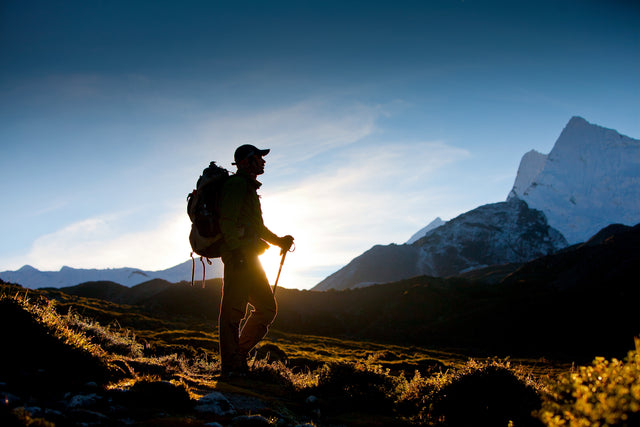Lighten Your Load, Elevate Your Adventure: Ultralight Hiking Gear and Packing Tips
Hiking has a way of captivating our spirits, drawing us into the beauty of nature, and providing an escape from the bustle of everyday life. It's a chance to immerse ourselves in stunning landscapes, breathe in the crisp mountain air, and challenge our bodies and minds along the winding trails.
Yet, as any seasoned hiker knows, the right gear can make all the difference between a memorable adventure and a gruelling ordeal.
Many outdoor enthusiasts have turned to ultralight hiking gear in the quest for a more enjoyable and liberating hiking experience. The philosophy behind ultralight gear centres around reducing weight without sacrificing functionality, allowing hikers to move with greater agility, minimise fatigue, and truly immerse themselves in the journey. It's a revolutionary approach that embraces minimalism and encourages us to shed unnecessary burdens, both physical and mental, on the trail.
In this article, we will embark on a journey of exploration and discovery as we unveil the world of ultralight hiking gear.
The Essence of Ultralight Hiking
Ultralight hiking gear is not just about shedding ounces; it's a mindset. It prioritises efficiency, durability, and intelligent design to create lighter equipment without compromising essential features.
Lightweight Hiking Gear Essentials
Every serious hiker has a non-negotiable hiking toolkit they take with them on every outdoor adventure. Some of these items may already be in your toolkit, but going ultralight means scaling up your hiking equipment and lessening your load.
1. Ultralight backpacks
These backpacks are designed to have a streamlined appearance and are made from durable materials that minimise weight while maintaining functionality and longevity.
Some key features of ultralight backpacks include:
- Lightweight materials such as high-tenacity nylon
- Minimalistic designs that prioritise essential features
- Frameless or lightweight frames made of aluminium or carbon fibre
- Smaller capacities ranging from 30 to 50 litres
- Simple and adjustable straps for a personalised carry experience,
- Roll-top closures for better weather resistance
- Integrated storage solutions like mesh pockets or attachment points for gear such as trekking poles, water bottles, and sleeping pads
When choosing an ultralight backpack, it's important to think about your individual requirements, the length of your journey, and the equipment you intend to bring along. Although these backpacks are practical and lightweight, bigger and more conventional packs could provide greater comfort and additional features. Adequate planning and packing expertise are critical for a successful ultralight backpacking adventure.
2. Featherweight hiking tents
If you're a backpacker who values comfort but doesn't want to carry a heavy load, ultralight hiking tents are the perfect solution.
Consider the following when choosing a lightweight tent:
- Look for tents made of ultralight materials with streamlined designs and compact packing.
- Choosing a tent that's easy to set up is important, with adequate interior space and weather resistance.
- Ensure the tent is well-constructed.
- Read reviews to see how the tent performs in your desired conditions.
Keep in mind that featherweight tents offer a balance between comfort and weight, so choose one that suits your personal needs and the conditions of your trip.
3. Ultralight sleeping bags
These sleeping bags are designed with high-tech materials and techniques that balance insulation, weight, and packability.
Key features to look for when choosing an ultralight sleeping bag:
- Ultralight sleeping bags often use down or synthetic insulation. Down is lightweight and compressible, while synthetic insulation is more moisture-resistant and better for wet conditions.
- When choosing a down sleeping bag, look for high fill power, which measures the quality of the down insulation. Higher fill power means more warmth with less weight.
- Make sure the sleeping bag's temperature rating matches the conditions you'll encounter. Choose a bag with a slightly lower rating than you expect to be safe from unexpected drops in temperature.
- Ultralight sleeping bags often have a mummy shape, which reduces excess space and helps retain heat efficiently.
- Look for sleeping bags with baffles to prevent insulation from shifting and causing cold spots.
- Ultralight sleeping bags use lightweight, breathable, and water-resistant fabrics for the shell and lining.
- Choose a sleeping bag with a durable zipper and a hood that cinches tightly to trap warmth.
- Check the sleeping bag's packed size to ensure it's easy to fit in your backpack.
- Choose a sleeping bag that matches your height and body size.
- Consider using a sleeping pad with your sleeping bag for extra insulation and heat retention.
Remember, proper layering and clothing also play a role in staying warm in an ultralight sleeping bag. Wear dry and insulating layers, like thermal baselayers, to enhance the bag's performance in cold conditions.
4. Compact cooking systems:
When going on outdoor adventures, such as backpacking and hiking, it's crucial to have compact cooking systems that are both efficient and lightweight. These systems enable you to prepare satisfying meals while keeping your gear easy to carry.
Here are some solutions to help you enjoy delicious meals on your travels:
- Choose a lightweight and efficient backpacking stove that uses canister fuel or alcohol.
- Consider integrated cooking systems that include a stove, pot, and accessories.
- Opt for durable and lightweight cookware made from titanium or hard-anodised aluminium.
- Use freeze-dried or dehydrated meals that only require hot water for preparation.
- Bring multi-functional cooking tools like sporks and collapsible silicone bowls.
- Pack compact utensils like folding knives and nesting cups to minimise space usage.
- Plan meals that use similar ingredients to reduce the number of items you need to carry.
- Use a lid on your cooking pot to speed up water boiling and save fuel.
- Practice using your compact cooking system at home before heading out on a long trip.
- Remember to pack enough food to sustain you throughout your trip and practice Leave No Trace principles while cooking in the backcountry.
With the right cooking system and some thoughtful planning, you can enjoy delicious and satisfying meals while exploring the great outdoors.
5. Trail footwear options:
Choosing the right footwear for hiking and backpacking is important to ensure comfort, support, and reduced weight.
Factors to consider when choosing hiking shoes:
- Assess the type of terrain you'll encounter, whether rocky, muddy, or uneven, to choose suitable footwear with the right traction and support.
- Consider the length of your hike and the kilometres covered each day to determine the appropriate level of footwear comfort and durability.
- Factor in your backpack's weight to find footwear that provides adequate support and cushioning for your feet.
- Decide on the level of ankle support based on personal comfort and the difficulty of the trail.
- Ensure a comfortable fit by trying different brands and styles that accommodate your foot shape.
- For warmer climates, opt for breathable materials to keep your feet cool and dry.
- Evaluate the need for water-resistant or waterproof footwear depending on weather and trail conditions.
- Balance weight reduction with durability by choosing high-quality materials and construction.
- Consider the time needed for footwear to mould comfortably to your feet during the break-in period.
- Recognise that ultralight footwear may have a shorter lifespan and plan for replacement accordingly.
Remember that each person's feet are different, so it's important to try out different options and consider your specific needs and the type of trails you'll be tackling. Consult with experienced staff at outdoor gear stores for personalised recommendations based on your activities and foot shape.
Smart Packing Strategies for Ultralight Adventures
When packing for your outdoor adventure, it's important to prioritise functionality and necessity. This means only including essential items in your pack to keep it lightweight and efficient.
Additionally, it's a good idea to choose multi-purpose gear that can serve multiple functions, reducing the need for redundant items. When it comes to clothing, mastering layering techniques can help you adapt to changing weather conditions without carrying excess weight. To save space and reduce pack weight, pack only essential hygiene items in travel-sized containers.
Finally, optimise your food and water choices by selecting lightweight, high-calorie meals and carrying water based on availability along the trail to maintain sustenance without adding extra weight to your pack.
With these smart packing strategies, you'll enjoy a lighter load, increased comfort, and the freedom to immerse yourself in the exhilarating world of ultralight adventures fully.
Tips for Maintaining Safety and Comfort
When preparing for a hike, it's important to prioritise safety by packing essential items for emergency situations. We can help you identify these items to ensure you're prepared for unexpected events without adding too much weight to your pack. This includes carrying a well-stocked first-aid kit, navigation tools such as a map or compass, a reliable multi-tool or knife, an emergency shelter, and fire-starting equipment.
It's also possible to maintain comfort on the trail without sacrificing weight reduction. Small luxuries that can make a big difference include a compact camping pillow, lightweight camp chair or sit pad, cosy camp slippers or extra socks for added comfort.
Finally, we understand that everyone's hiking journey is unique, so we can guide you through the process of customising your gear choices to strike a balance between weight reduction and meeting your personal needs.
This includes evaluating your specific requirements, investing in gear that aligns with your outdoor goals and the environments you'll be exploring, testing equipment to ensure it fits your body and complements your hiking style, and considering weather conditions, trip duration, and potential challenges.
Finding the Balance: Functionality vs. Weight Reduction
As you delve into the world of ultralight hiking gear, a myriad of choices awaits you. Consider your individual preferences, hiking style, and the unique demands of your adventures to strike the right balance between functionality and weight reduction. Before embarking on a long hike, take the time to test and adjust your gear choices.
Conduct trial runs to ensure you feel confident and comfortable with your selections before embarking on your grand hiking escapade. With thoughtful consideration and practical experience, you'll discover the perfect gear combination that enhances your outdoor experiences while keeping your backpack light and efficient.
In conclusion, we'll leave you with an encouraging nudge to lighten your load, embrace the world of ultralight hiking gear, and savour every moment of your hiking journey. Remember, the trails await – it's time to elevate your adventure!


0 Comments
There are no comments for this article. Be the first one to leave a message!